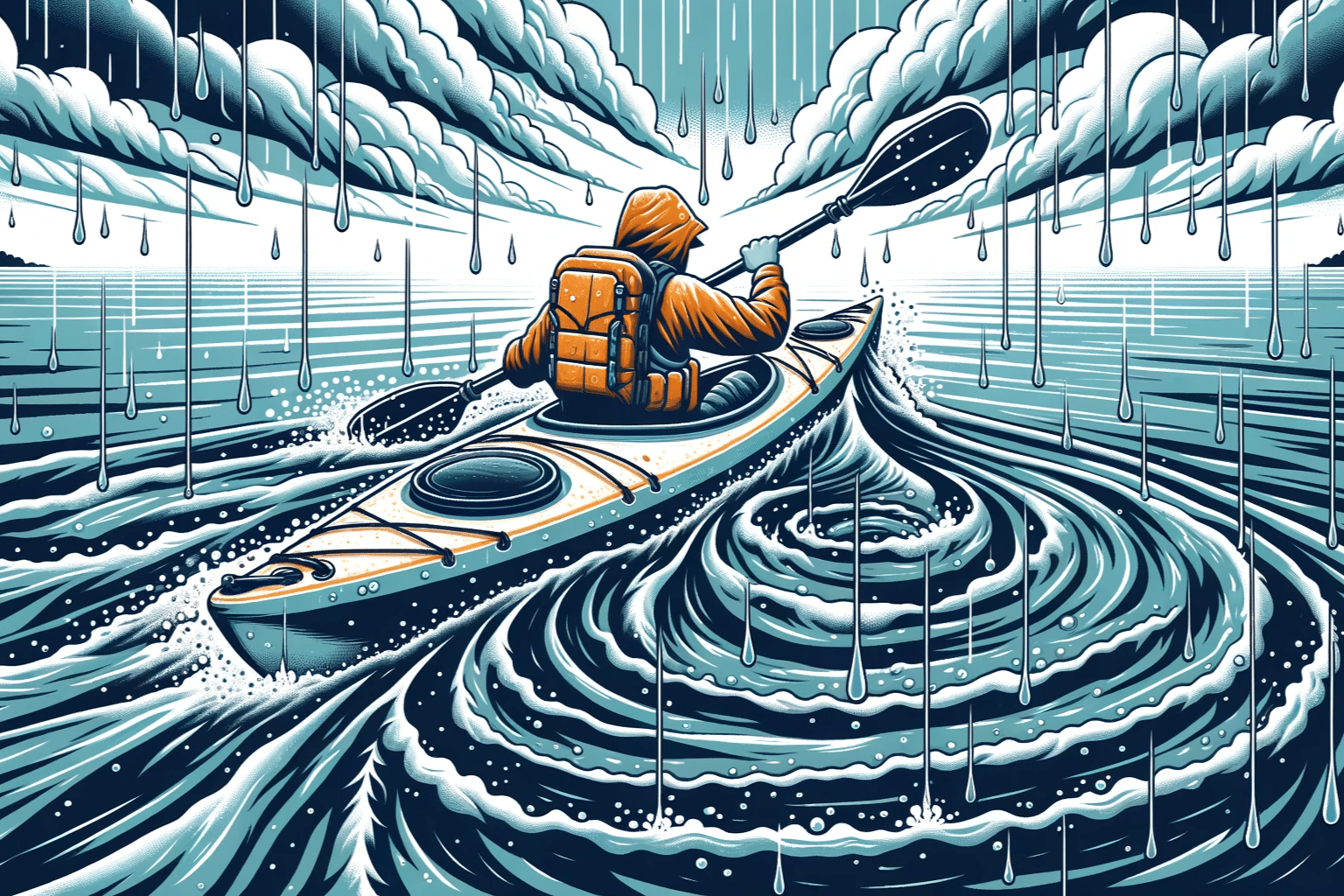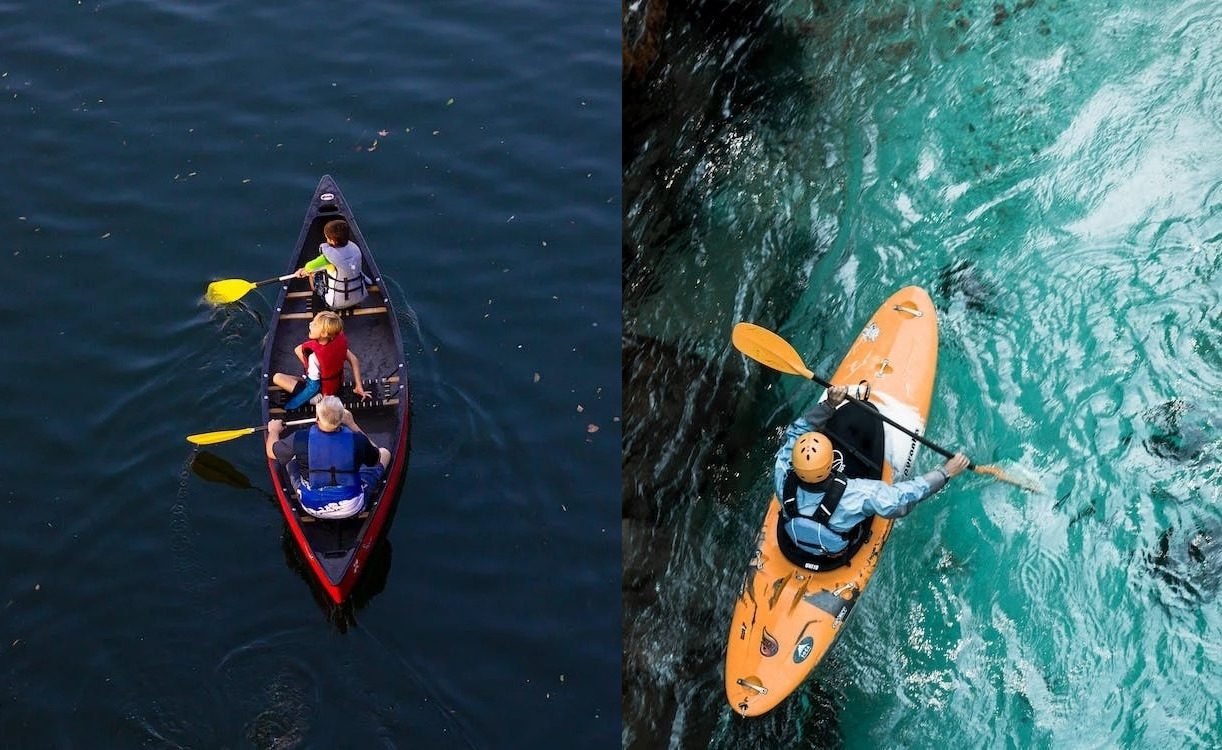Weather is a fickle friend, especially when you’re itching to get out on the water. But here’s the thing: A rainy forecast doesn’t have to put a damper on your kayaking plans. Quite the opposite! The thrill of Kayaking in the Rain can turn an ordinary paddle into a memorable experience.
With the right knowledge and taking proper precautions, you can enjoy the unique ambiance that rainy weather brings. So don your waterproof gear and let’s dive into how to kayak in the rain safely.

Kayaking in the Rain – Key Takeaways
☑️ Can you safely kayak in the rain? Absolutely, if you’re well-prepared with waterproof gear, aware of the weather conditions, and understand the safety measures required for paddling in rain.
☑️ What essential gear do you need for rainy-day kayaking? Key items include a bilge pump to remove excess water, a paddling jacket for warmth, dry bags to protect your belongings, a spray skirt to keep the cockpit dry, and lights to enhance visibility.
☑️ How does rain affect paddling conditions and techniques? Rain can alter water levels and visibility. It requires adjusting your paddling technique for control and ensuring high visibility to others on the water.
☑️ Why might kayaking in the rain be considered rewarding? The rain adds a layer of serenity and challenge, providing a peaceful environment and a more intense workout, enhancing both the mental and physical benefits of kayaking.
Is Kayaking in the Rain Safe?
Yes, kayaking in the rain can be a safe activity, but it comes with its own set of unique safety concerns. These range from fluctuating water levels and strong currents to reduced visibility and the risk of hypothermia. While rain might add a thrilling dimension to your paddling experience, it also ups the ante when it comes to safety precautions you’ll need to take.
It’s important to know your limits and abilities when it comes to kayaking, especially under challenging weather conditions. If you’re a beginner or even an intermediate paddler, be extra cautious when deciding to go out in the rain. Consult weather forecasts, monitor river and water levels, and assess your skill level in tandem with the current conditions. The latter sections of this article will dive more deeply into each of these concerns and offer practical advice for mitigating risks.
When conditions worsen, or if you’re feeling out of your depth, it’s crucial to not take unnecessary risks. The water may seem inviting, but when combined with factors like heavy rain, strong currents, or bad weather, it can become a hazard quickly. It’s always better to err on the side of caution and head back to shore than to push your limits in risky conditions.
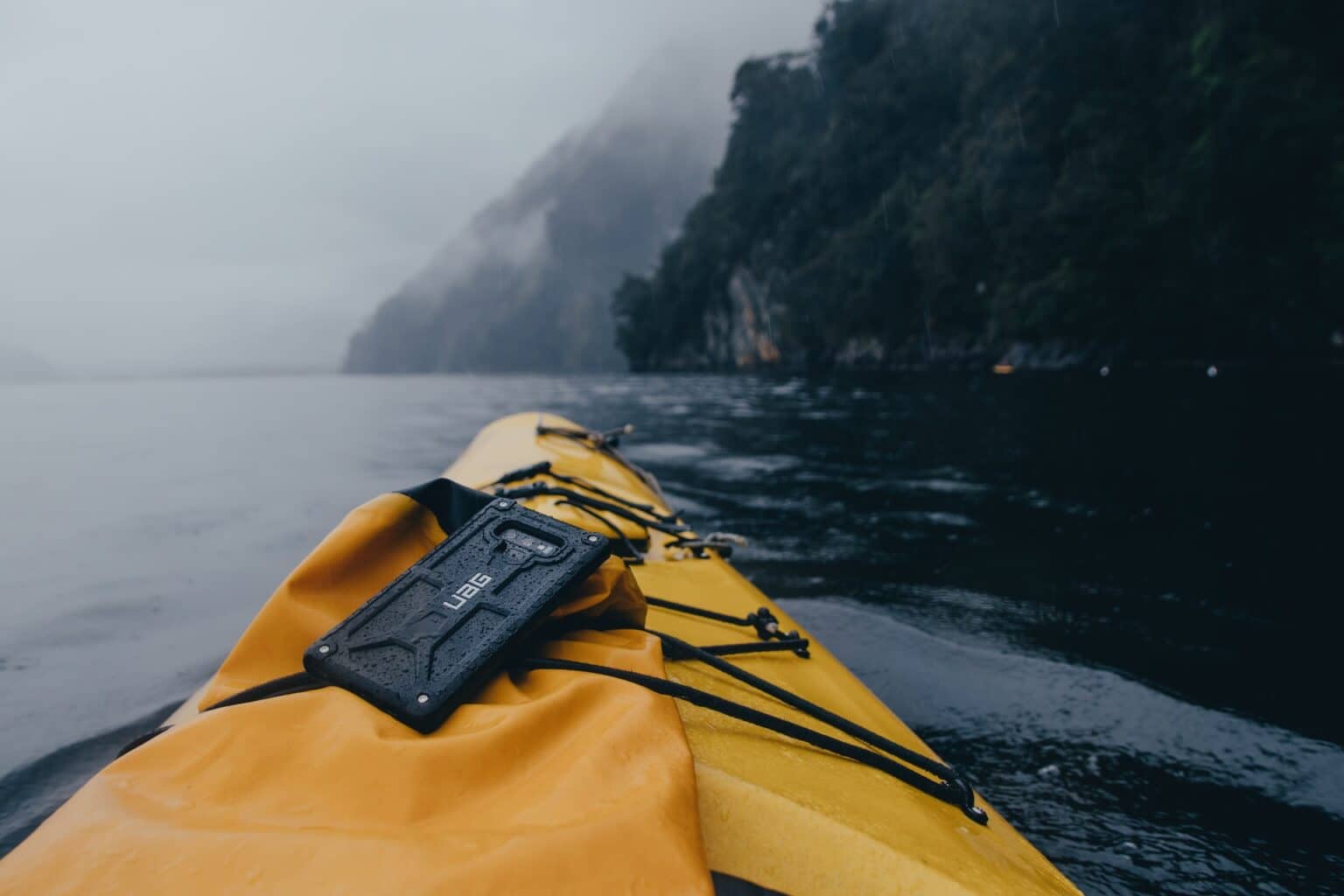
Planning and Preparing for a Rainy-Day Kayak Trip
Weather Forecast
The cornerstone of any well-planned kayaking trip, especially one where rain is expected, is a solid grasp of the weather forecast. Reliable weather apps or marine forecasts can offer valuable insights into the conditions you’ll face. Remember, sometimes rain can come with friends—like strong winds or sudden temperature drops. Always plan for the worst and hope for the best. Knowing the weather in advance can mean the difference between a memorable kayaking experience and a potentially dangerous situation.
Checking Water Levels
Water levels can make or break your kayaking in the rain experience. High water levels might signify stronger currents and choppier waters, while low levels could mean scraping the bottom of your kayak more than you’d like. Websites and apps dedicated to monitoring river levels can offer real-time updates that you can use to gauge the safety and feasibility of your trip. So, before you go, always check current water levels against historical data for the same time of year to better predict what you might encounter.
Plan Your Route
Route planning isn’t something you should do on the fly, especially when kayaking in the rain. Use a map to outline your journey, marking safe zones and potential exit points. Know where you can seek shelter in case conditions worsen. Also, make sure to inform someone reliable about your plans and your estimated time of return, because, when it comes to water sports, it’s always better to have a safety net.
Increase Your Visibility
Rain and fog can dramatically reduce visibility on the water, not just for you, but also for other boaters who might be sharing the waterway. Consider using a brightly colored kayak, wear high-visibility clothing, and install a kayak light to make yourself more visible to others. In that regard, paddling on a rainy day is similar to paddling at night. Low visibility conditions also make signaling devices like whistles or air horns a good idea to carry along.
Remember, preparation is half the battle. Taking the time to understand the weather, and water levels, and mapping out your route can save you from a lot of unnecessary headaches later on. Equally important is making yourself visible to others to avoid accidents on foggy or rain-soaked trips.
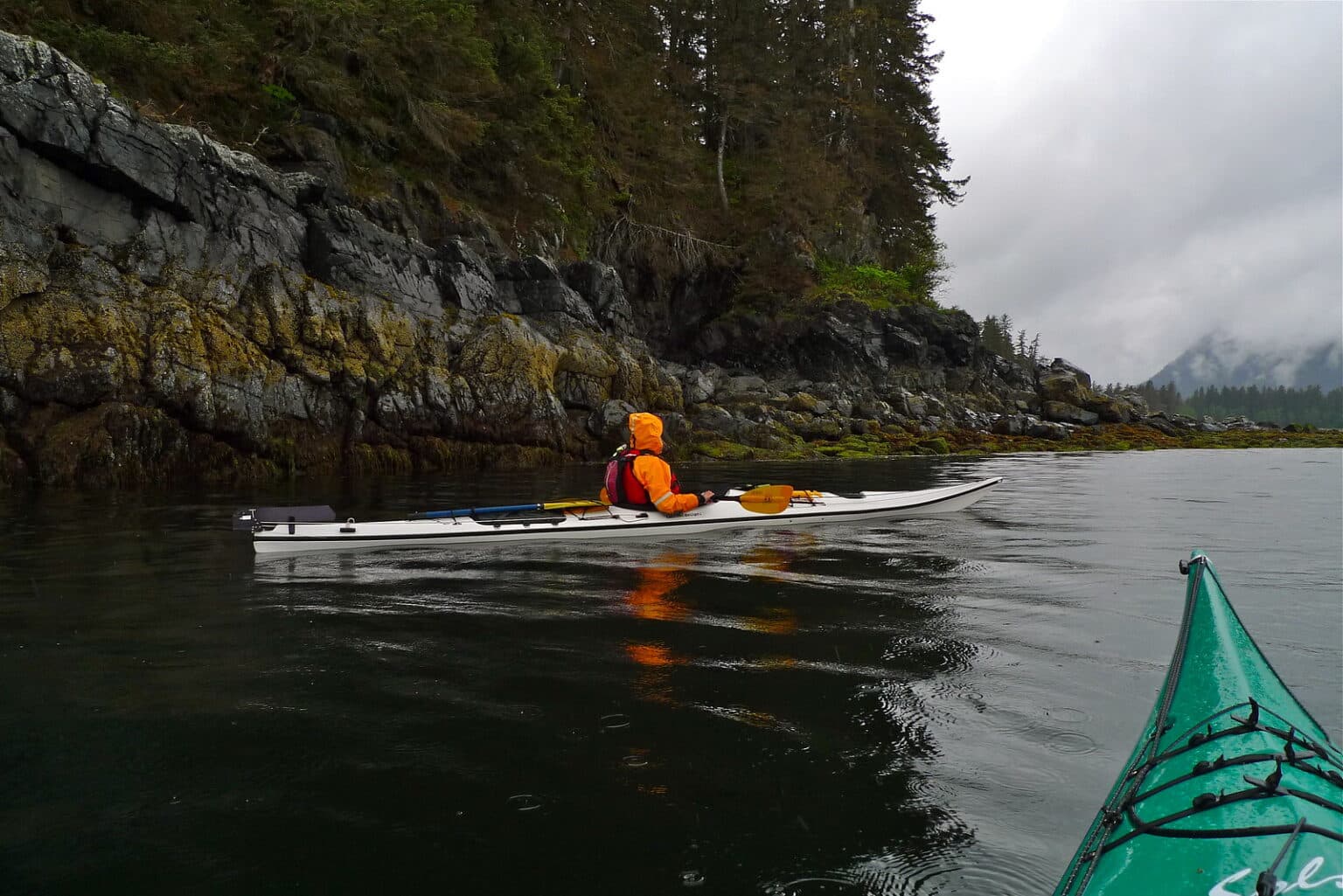
Gear and Clothing for Rainy Kayaking
Essential Gear
When kayaking in the rain, some gear items are simply non-negotiable for a safe and comfortable experience. Here’s a list of must-haves:
- Bilge Pump: You’ll be dealing with more water than just what’s beneath your kayak. A bilge pump helps to easily remove any water that might find its way into your vessel.
- Paddling Jacket: Choose a jacket specifically designed for paddling. These are usually constructed from waterproof material and feature wrist and waist seals to keep water out.
- Dry Bags: These will protect your essential items, like your smartphone and keys, from water damage.
- Spray Skirt: This seals the area around your waist to prevent water from entering the kayak’s cockpit.
- Kayak Lights: In cloudy or foggy weather conditions, kayak lights increase visibility for both you and others on the water.
Additional Gear Recommendations
If you’re looking to enhance your rainy kayaking experience, here are some additional items to consider:
- Paddle Float: Useful for re-entering your kayak if you capsize.
- Waterproof Gloves: Neoprene gloves can keep your hands warm and provide a better grip.
- Waterproof Phone Case: Protects your phone from water damage and allows for secure storage during your trip.
- Navigation Tools: Consider a waterproof GPS or compass.
- Footwear: Amphibious shoes with a grip can keep you stable in slippery conditions.
Choosing the Right Clothing
Your choice of clothing can make or break your kayaking trip, especially in the rain. A paddling jacket is essential, but it’s just the starting point. Wet suits and dry suits come in handy depending on the water temperature and weather conditions. Wet suits are usually made from neoprene and are great for colder water as they trap a layer of water between the suit and your skin, which warms up to insulate you. Dry suits, on the other hand, are entirely waterproof and more suitable for colder air temperatures.
Materials to Consider:
- Synthetic Materials: Fabrics like polyester or polypropylene are quick-drying and moisture-wicking.
- Waterproof Material: Obviously crucial for rain gear and outer layers.
Why Layering is Crucial
Layering is the best way to regulate your body temperature, especially when kayaking in varying weather conditions. Here’s a basic guide:
- Base Layer: This sits closest to your skin and should be made of moisture-wicking material to keep you dry.
- Mid Layer: This is your insulation layer. Fleece is a good option because it retains heat even when wet.
- Outer Layer: The waterproof layer, like your paddling jacket or a rain jacket, protects you from rain and wind.
The idea behind layering is to add or remove layers to keep your body temperature just right. In rainy and cold temperatures, your body temperature can drop quickly, especially if you’re wet. By layering, you can remove or add pieces without compromising your comfort or safety.
Paddling Techniques and Tips for Kayaking in the Rain
Adapting Paddling Techniques
Rainy weather poses unique challenges that require adjustments to your paddling technique. Wet conditions can make the paddle slippery, affecting your grip. Wrapping a tennis grip or using gloves with a good grip can remedy this issue. You might also find that with increased water levels, your kayak becomes more buoyant, which can both be an advantage and a challenge. In higher water levels, short, quick strokes offer better control as opposed to long, sweeping movements.
Maintaining Kayak Control in Wet Conditions
Rain often comes with additional elements like strong winds and cold water that can affect your kayak’s stability. To maintain control in strong winds, lower your body close to the deck to reduce wind resistance. Tilting the kayak into the wind can also give you an aerodynamic edge.
Cold water adds another layer of complexity. It can slow down your reflexes and make your movements sluggish. Practicing bracing strokes, like the low and high brace, can offer additional stability and control. These techniques involve using your paddle to create a support platform on the water’s surface, helping you regain balance and avoid capsizing.
Navigating through wet conditions, strong winds, and cold water can seem daunting. However, by slightly altering your paddling techniques and being mindful of how to maintain control, you can transform your paddling experience into something memorable and rewarding, even in the most challenging circumstances.
Master Self-Rescue
No matter how well you plan, unforeseen challenges can arise, particularly in rainy conditions where visibility and control can be compromised. This is where mastering self-rescue techniques becomes essential. Knowing how to get back into your kayak unassisted, or how to utilize your paddle float in a pinch, can be a lifesaver—literally. Whether it’s a simple capsize or getting stuck in a tricky current, self-rescue skills can turn a potential disaster into a minor hiccup.
If you’re new to kayaking or haven’t brushed up on your self-rescue techniques recently, consider taking a course or practicing in a controlled environment before embarking on a rainy day adventure. It’s always better to have these skills and not need them, than to need them and not have them.
Potential Risks and How to Avoid Them
High Winds and Rough Waters
Strong winds and turbulent waters are common accompaniments to rain and can compromise your kayak’s stability. It’s crucial to understand how to handle these conditions, which might include using certain paddling techniques to maintain balance. In high winds, lowering your center of gravity and paddling at a tilt can help. Rough waters may require you to perfect your bracing strokes, which can prevent accidental capsizing.
Cold Shock and Hypothermia
Rain usually leads to colder temperatures, and exposure to cold water can lead to cold shock or, in worse cases, hypothermia. Always dress appropriately for the weather conditions. Wetsuits or dry suits made from synthetic materials are excellent for maintaining body temperature. In colder conditions, it’s vital to layer your clothing effectively: start with a moisture-wicking base layer, add an insulating middle layer, and finish with a waterproof outer layer.
Lightning Strikes
Kayaking in the rain also comes with potential risks like lightning strikes. Always check the weather forecast for thunderstorms and avoid going out if there’s a chance of lightning. If you’re caught unexpectedly, head to shore immediately and seek shelter in a building or your car, never under a tree.
Flash Floods
Rain can significantly affect water levels, resulting in flash floods that could turn a serene paddling environment into a dangerous one. Higher-than-usual water levels can cause strong currents and bring debris into the water. Always check the water level reports before embarking on a rainy kayaking trip, and have a clear action plan for how to reach safety if conditions turn perilous.
Being well-prepared and knowledgeable about these potential risks will not only enhance your enjoyment of kayaking in rainy conditions but also substantially lower the chances of running into unnecessary risks. The key is to plan thoroughly, take all safety measures, and be prepared for various challenges that may arise.
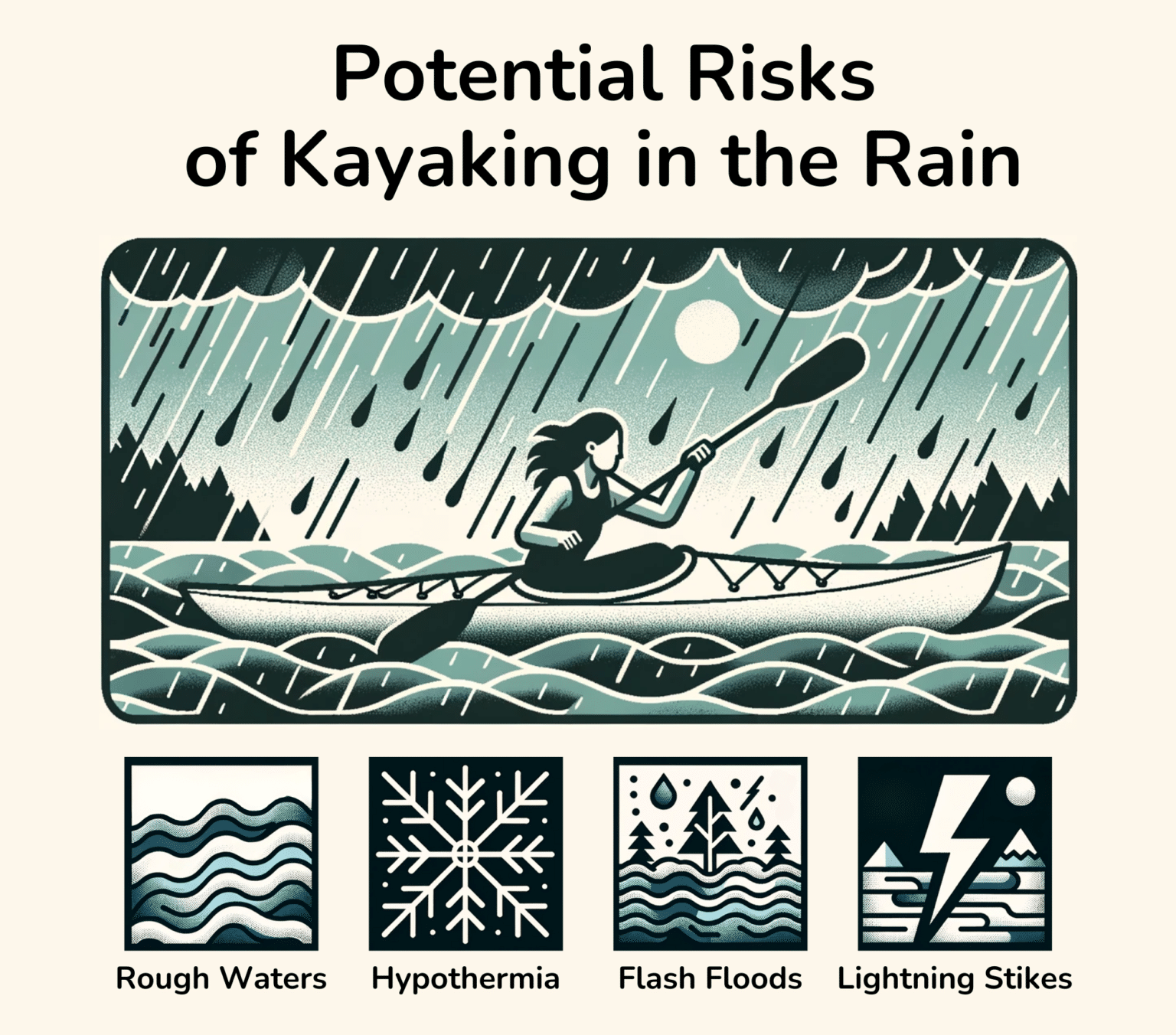
Water Conditions and Temperature
Interpreting Water Conditions
Understanding water conditions is paramount for safe kayaking, especially in rainy or bad weather conditions. Keep an eye on water clarity, flow rate, and the presence of debris. Rough waters require adept skills and possibly specialized equipment. Assess the water speed: too fast and you’ll be swept away; too slow and you risk stagnation and exposure to cold. You’ll also want to be aware of tide changes, which can dramatically alter water levels and currents.
Cold vs. Warm Rain
The temperature of rain can significantly impact your kayaking experience. Cold rain can quickly lead to hypothermia if you’re not adequately prepared. Cold water, combined with strong winds, can sap your body heat in no time. Your body is also more prone to fatigue in cold conditions, making it harder to control your kayak. Using dry suits and thermal layers can go a long way in such conditions. It’s also a good idea to bring high-energy snacks like nuts and protein bars to keep your energy levels up.
On the flip side, warm rain can be more forgiving but still presents its own challenges. It can induce a false sense of security, leading kayakers to underestimate other risks like strong currents or lightning storms. Moreover, warm rain can lead to visibility issues, as it causes fog to form over the water, making navigation trickier.
Both cold and warm rain come with their own sets of risks and precautions. Irrespective of the temperature, rain often brings strong winds, which can turn even a placid lake into a challenging environment. Therefore, it’s always essential to be prepared and respectful of Mother Nature’s whims while kayaking in the rain.
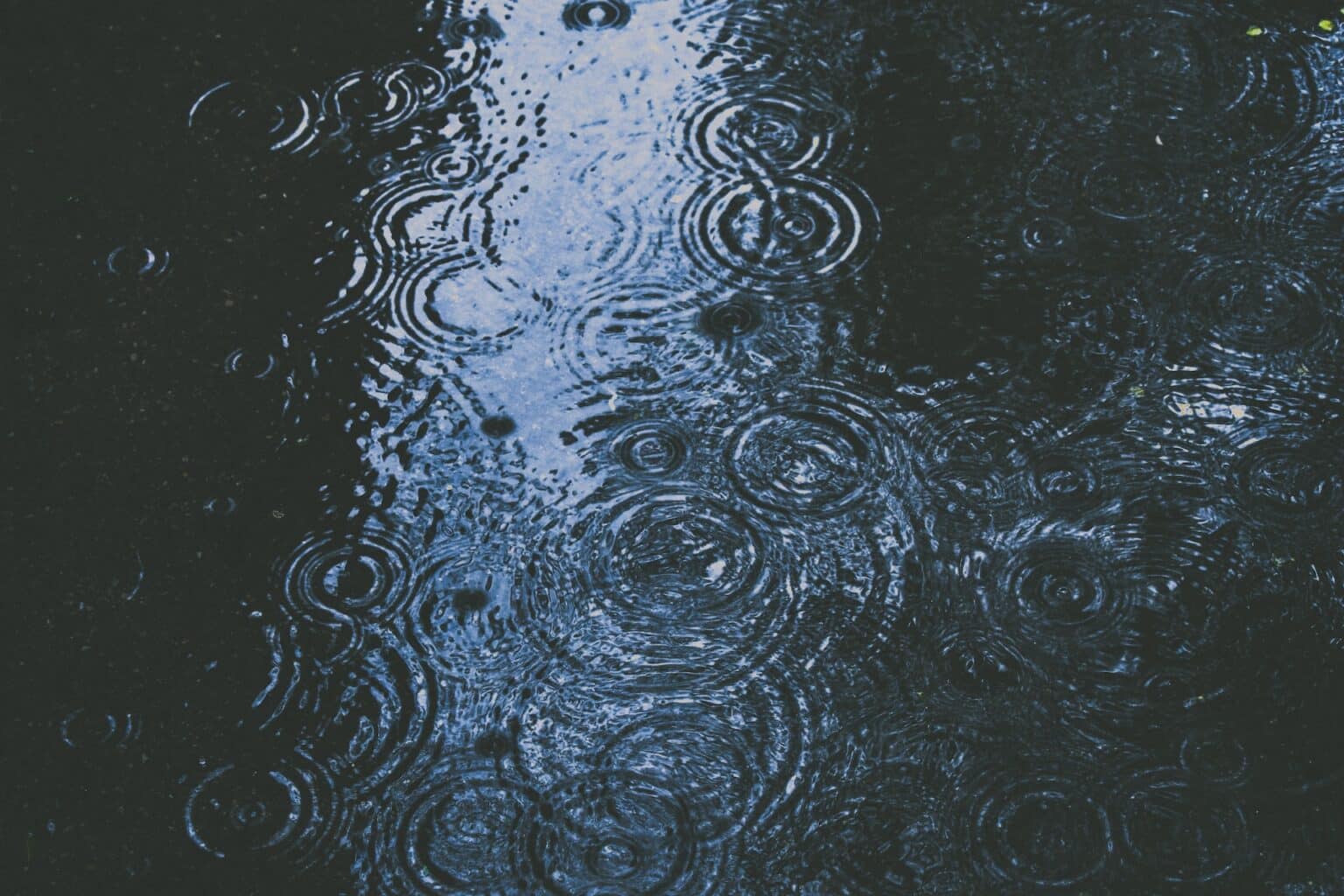
Benefits of Kayaking in the Rain
Unexpected Advantages
Believe it or not, kayaking in the rain offers some unique perks that you won’t find on a sunny day. For one, fewer people on the water mean a more tranquil experience. The water itself often becomes calmer during a steady rain, making it easier to paddle over a long period of time. Rain also brings out a different, richer set of colors in the natural world, adding a special aesthetic quality to your kayaking trip.
Mental and Physical Benefits
From a mental standpoint, paddling through the rain can be incredibly freeing. It allows you to engage with nature in a raw, untamed form, making the experience more authentic and memorable. The sound of raindrops hitting the water’s surface can be meditative, offering a form of stress relief that’s hard to find elsewhere.
Physically, kayaking in the rain can be more demanding, helping you burn extra calories. The added resistance from rainfall and potentially stronger winds test your body, requiring more strength and stamina. This means you’re not only challenging yourself mentally but also getting a more intensive workout, making rainy-day kayaking a thoroughly rewarding experience.
Frequently Asked Questions
Is it OK to kayak in the rain?
Absolutely, kayaking in the rain can be a delightful experience as long as you take proper precautions. Just remember to equip yourself adequately, and keep an eye on the weather forecast as well as water levels before setting out on your kayak trip.
What to do if caught in a thunderstorm while kayaking?
If you find yourself caught in a thunderstorm, the first thing to do is seek shelter immediately. It’s crucial to avoid being the tallest object in open water. If you can’t get to land quickly, lay low in your kayak and disconnect any metal objects. Always wear your personal flotation device in such conditions.
How do you stay dry kayaking in the rain?
While you can’t stay completely dry, wearing rain gear made from waterproof material can keep most of the water at bay. We recommend packing a hot water flask; sipping hot liquid can make a significant difference in your comfort level when paddling under wet conditions.
How do you get in and out of a kayak without getting wet?
Perfecting the art of getting in and out of a kayak without soaking yourself takes some practice. It usually involves balancing on one foot while sliding into the kayak, then gently lowering yourself in. Keeping a towel handy to sit on can also help absorb any residual moisture.
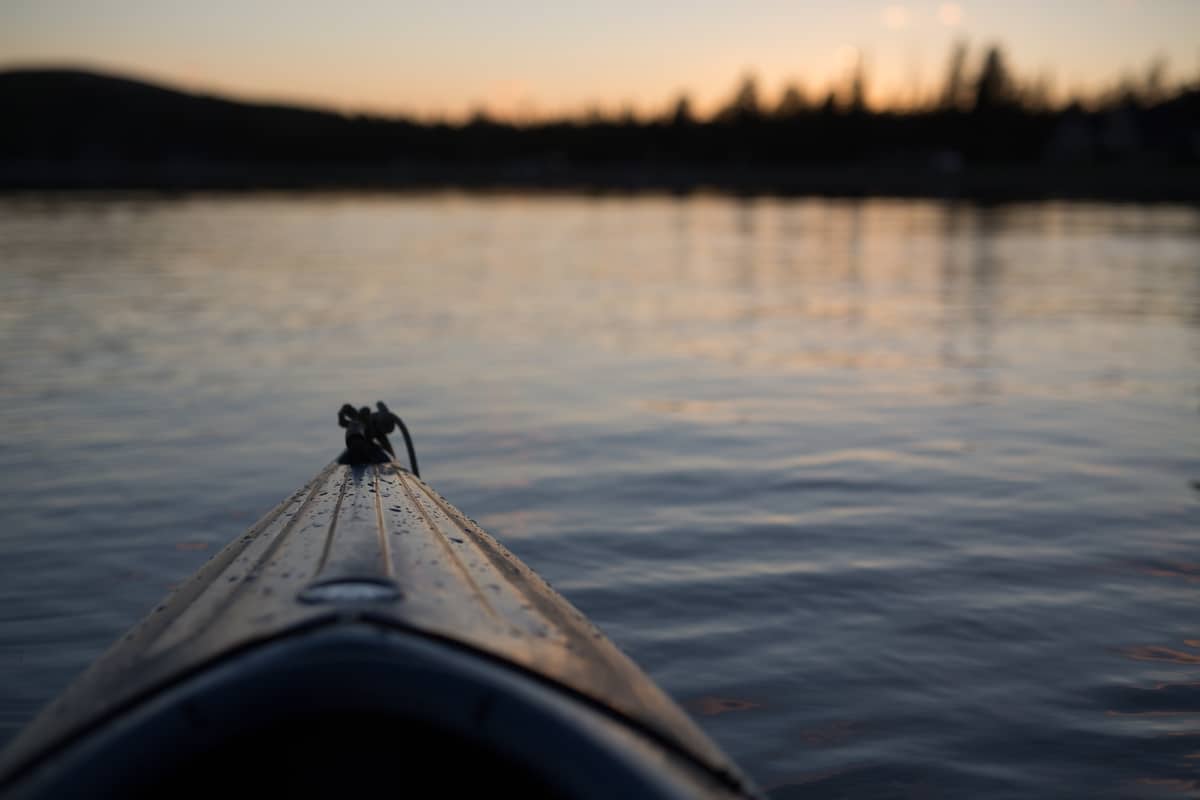
Conclusion – Kayaking in the Rain
Kayaking in the Rain doesn’t have to be a daunting experience. In fact, with the right preparation and mindset, it can be an unforgettable adventure. Prioritize safe kayaking by checking the weather forecast, understanding water conditions, and equipping yourself with the right gear. Don’t underestimate the role of proper clothing and layering, especially when you’re dealing with cold rain. It’s also crucial to understand the specific challenges posed by wet conditions, from adapting your paddling techniques to being aware of risks like hypothermia and lightning strikes.
So, what’s holding you back? With the proper precautions, even a light rain can transform your regular kayaking trip into something magical and memorable. If you’re eager to learn more about how to make the most of your outdoor experiences, don’t forget to check out other kayaking related articles on The Sporting Edge!

